Menus
- BMW’s tourer spearheads in a comparison test
- Conclusion
- Technical specifications
- Noticed
- Fascinating six-cylinder

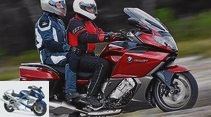
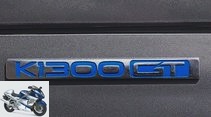
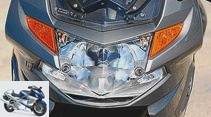
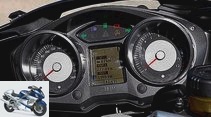
21st photos
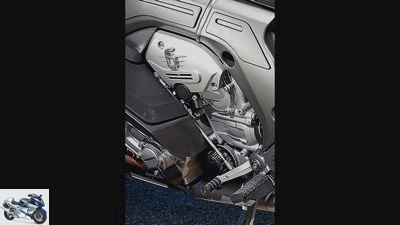
1/21
The approximately 40 centimeter long shift linkage of the six-cylinder may be responsible for the long shift travel and the very doughy shift feel.
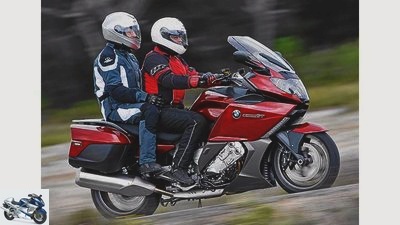
2/21
Front and rear, the knee angles are wider on the 1600 than on the K 1300 GT.
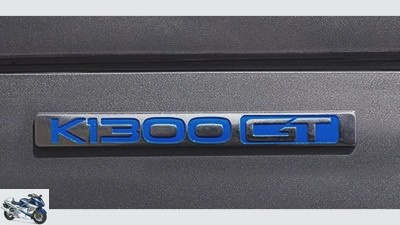
3/21
The previous king of points – the BMW K 1300 GT.
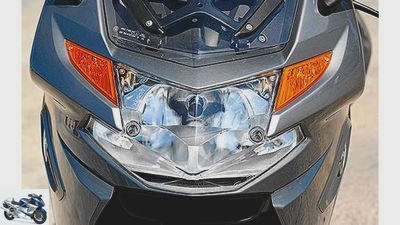
4/21
Xenon light of the K 1300 GT. Shines brighter than the headlights of the 1600s.
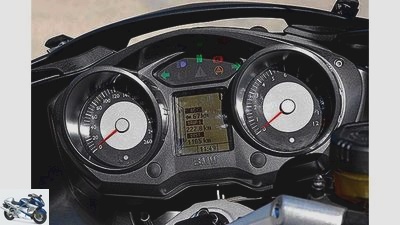
5/21
The cockpit of the BMW K 1300 GT with LCD.
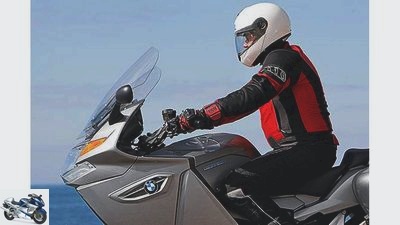
6/21
The adjustable windshield of the K 1300 GT.
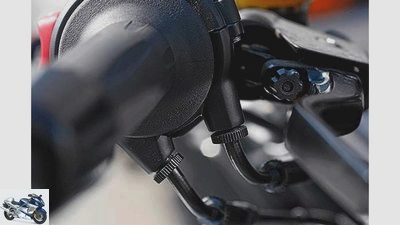
7/21
The throttle cables of the K 1300 GT.
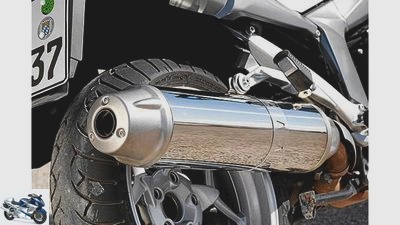
8/21
The 1300 carries a four-in-one stovepipe.
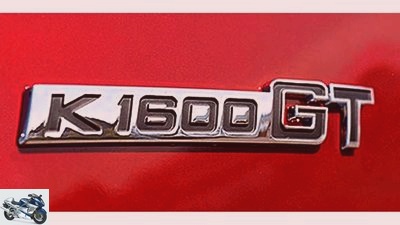
9/21
Is the K 1600 GT a worthy successor?
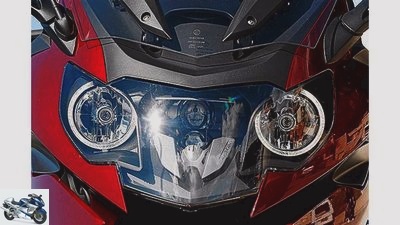
10/21
The 1600 series has LED parking lights around the high beam, Xenon cornering lights in the middle.
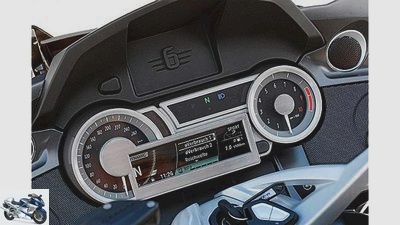
11/21
The colorful, easy-to-read, high-contrast TFT screen sits between the unevenly sized watches from the 1600s.
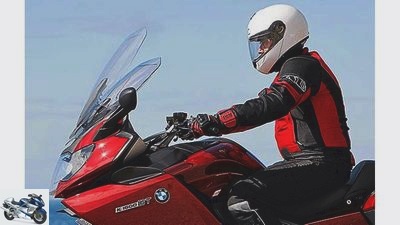
12/21
The larger disc of the 1600s moves further up and forward. The 1300s windshield is lower down and louder up.
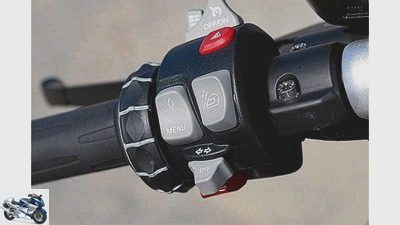
13/21
The rotary wheel (multicontroller) of the 1600 controls ESA, on-board computer and heating.
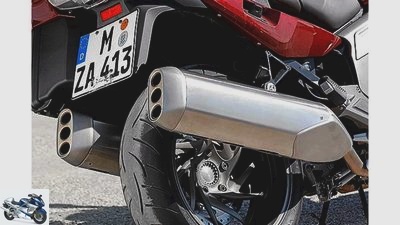
14/21
Six outlets of the six-in-two exhaust system refer to the engine.
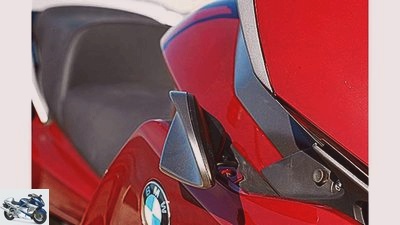
15/21
The adjustable wind deflectors on the left and right in the cladding of the 1600s are extremely effective at guiding cooling air to the chest and stomach when the air is warm.
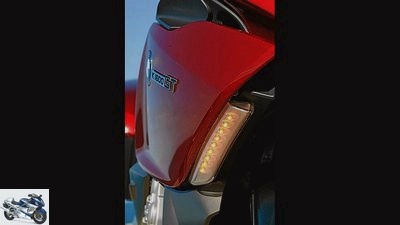
16/21
Like the rear lights, the turn signals of the 1600s are designed as low-wear LEDs, but they look a little deep at the front, hidden away.
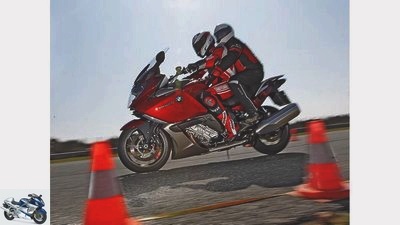
17/21
Solo top, the K 1600 GT only falls slightly behind the 1300s when the brakes are fully applied with a pillion passenger.
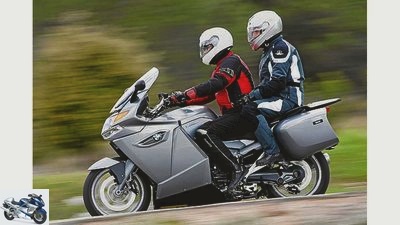
18/21
On the 1300, the passenger sits higher, further away from the driver.

19/21
With the 1300, the handlebars can be easily adjusted in height. One such "Accommodating" the new GT would have looked good too.
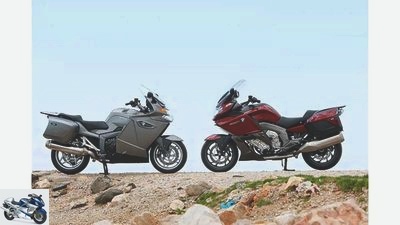
20/21
Who is the winner in the comparison?
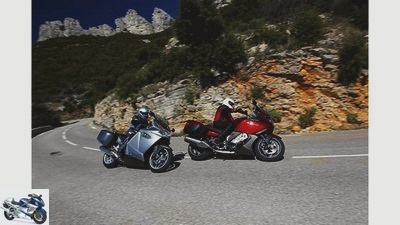
21/21
BMW’s famous six-cylinder K 1600 GT reaches for the crown of Gran Turismo. A worthy opponent for the K 1300 GT? The two meet in the top test.
Top test: BMW K 1600 versus K 1300 GT
BMW’s tourer spearheads in a comparison test
BMW’s famous six-cylinder K 1600 GT is reaching for the crown of Gran Turismo, and in the top test it meets MOTORRAD’s previous winner, the K 1300 GT. Especially spicy because the 1600 tourer replaces its four-cylinder predecessor. A worthy new sovereign?
Autoroute du Soleil, the A7 from Lyon to Marseille. On board the BMW K 1600 GT, the windshield is high, the brand new six-cylinder purrs constantly with cruise control 130, and the spring in the south of France caresses the face. BMW’s first six-cylinder motorcycle has dressed in purple for a royal get-together. The four-cylinder BMW K 1300 GT in table silver, the previous head of the Bavarian-Berlin touring guard and the most powerful tourer in the world, sails in tow. At the same time, the old GT was the master of the 1000-point rating from MOTORRAD with the highest rating ever achieved.
GT the first, because now the 1600 replaces the 1300. As an Exclusive Edition, it has once again put on full regalia: In the final series everything is included at a price of 19,450 euros: electronically adjustable ESA II chassis, traction control, tire pressure monitoring, xenon light, heated grips, seat heating, on-board computer and a large 49-liter Topcase with lacquered lid. The latter is missing from the 1600 at 19,900 euros base price. For comparable equipment, the 1600 series adds 2000 euros for two equipment packages.
Buy complete article
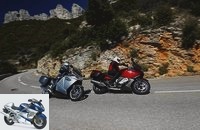
Top test: BMW K 1600 versus K 1300 GT
BMW’s tourer spearheads in a comparison test
Who is the winner in the comparison?
So far, no sensible person would have accused the extremely powerful 1300 four-cylinder engine of weak torque. But the famous six-cylinder completely shifts the perception, so casually it shakes its performance out of its sleeve. Almost 140 Newton meters at 2000 rpm according to the test bench measurements – a maximum of 174 at 5200 tours, and 159 hp at a moderate 7900 rpm – catapult the 342 kilo colossus forward incredibly. Incomparable, this thrust from the speed basement. When fully turned out, the touring trump accelerates from zero to 100 in 2.9 seconds, and from zero to 200 in ten seconds, without ever appearing strenuous.
Since the 40 kilogram lighter, above six hp more powerful 1300 initially struggled to stay tuned. Only at higher speeds can she intercept her successor. After all, with the more important passage in sixth gear, the "small" GT the big one behind. Either way, 7.6 seconds from 60 to 140 in the sixth is a great value for the 1600s. And 6.0 imposing in the fifth. This is top dynamic in the seven hundredweight class. At the freeway speed of 130, the four-cylinder crankshaft rotates 5,000 times per minute, and only 3900 times in the straight-six. Even in fifth gear, the large GT turns lower than the small one in sixth. A truly royal drive.
Ultimately, you can drive both BMWs extremely lazy. Because it always goes one gear higher than usual. With the 1600s, it’s more like two of them. Even the tightest turns can be enjoyed in third or fourth gear. In addition, the finest running culture spoils you with perfect mass balancing. The 24-valve engine runs silky smooth, especially in the first half of the speed, before the rapid increase in torque between 4000 and 5000 tours. As if its 12.9 kilogram crankshaft was rotating in butter plain bearings. Sixism in its purest form. Only from the middle of the rev range can you feel that the engine is running. The 1300 never leaves any doubt about that. It vibrates noticeably, its engine runs a lot rougher, especially when you take off the accelerator.
The six-cylinder has three driving modes ready. The driving mode that goes well with the GT speaks most aggressively "Dynamic" at. In stage "Road" the engine reacts a little more slowly, "Rain" additionally cuts the power output at medium speeds. However, the electronics always implement the turning of the e-throttle with more or less delay: as a result of the single, electronically controlled throttle valve or the extremely long intake path (see technology box). The 1300 depends more on the gas. It conventionally has four throttle valves. The clutch of the six-cylinder is extremely easy to pull. When the self-reinforcing mechanism in the clutch basket is active, the hand lever moves out a little as if by magic. Only the dosing range should be more precise. The drive train of the six-cylinder has a lot of play, it scales and rattles when accelerating, accelerating to in the partial load range. Not princely. Engaging first gear is accompanied by a hard gear shift typical of BMW in the past. The shift paths are long. The K 1300 GT switches with more clicks and more precisely.
The larger disc of the 1600s moves further up and forward. The 1300s windshield is lower down and louder up.
When lifting from the side stand to the vertical and when pushing or maneuvering, the 1600 cannot deny its weight. This takes strength, experience and determination. But the picture rotates while driving. The ten-cylinder duo is now touring on the smallest of streets in Provence, under pine and plane trees. Crazy, the mighty 1600er turns in even more easily than the stiffer and more stable 1300er, folds out very easily. The six-cylinder is well balanced, wags loosely and lively, rolls more manageable, rounder and more precisely through the curves. Despite an even longer wheelbase. It remains absolutely unimpressed on course even in deep lean angles, no matter what. It doesn’t matter that his lower and further forward footrests rubbed off the fear nipples earlier.
This neutrality creates basic trust, especially in turns. The giant neither stands up nor falls further into hairpin bends. BMW can build chassis. The 1600 can be moved incredibly quickly. Crazy. The large GT always conveys a wonderful feeling of security and security. Easy keeps the very fast 1300s in check. Because greater steering precision and more grip add up to easier handling.
Both GTs rely on special Metzeler rear tires with special identification: Double nylon carcasses are supposed to offer a lot of stability despite the high weight and grueling torque. But the modern Metzeler Z8 Interact "C." adheres much better than the Z6 "K" the 1300s. Time and again, the 180 smears away, the motorcycle stands sideways despite traction control, while the 1600 pulls its course on its 190, also with a 55 cross-section. It’s amazing how the travel giant lets himself be scared up and down the mountains.
In return, there is always more movement in Her Majesty’s chassis than in its predecessor. Here as there are slim-cut light metal bridge frames with screwed-on aluminum stems. And yet Duolever front wheel guides and Paralever single-sided swing arms don’t do exactly the same thing. The individual shock absorber at the front and rear of the 1600 series is even more sensitive, turning the six-pack into a comfort litter. Moguls, potholes, pitted asphalt? No matter The spring elements of the 1300s respond slightly more trampling. It rides better with a pillion passenger, which, surprisingly, is more noticeable on the 1600s.
Six outlets of the six-in-two exhaust system refer to the engine. The 1300 carries a four-in-one stovepipe.
ESA II very effectively adapts the chassis to both road conditions, load and driving style at the push of a button: It regulates the rebound damping at the front and rear as well as the spring preload of the rear shock absorber, plus its spring rate and thus the "hardness" the spring electronically. However, in comfort mode, the 1600er becomes significantly more spongy – more unstable and less precise in steering. At top speed, limited to 250 km / h, it also shows a tendency to stir, which the 1300s only show with a topcase. In emergency braking, the big one dances a little with its hindquarters, but stands a bit earlier on its own than the crisp, adjustable 1300. Both BMWs brake brutally.
Although the 1300s achieved full points in terms of equipment, the 1600s sets standards here. For example through interfaces for MP3, USB, iPod, Bluetooth and other audio devices. A premiere is the 5.7 inch TFT color display, rich in contrast, colorful and easy to read even when the sun is high. Works like smartphones. It shows all information from the even more comprehensive on-board computer and the selected settings, such as the five heating levels (!) For the handles and the front seat.
The adaptive cornering light of the 1600s shines at night. Although the xenon headlights of the 1300s shine brighter, it is believed that if you switch, you will no longer be able to ride a motorcycle. Because the cone of light repeatedly folds down in curves to the left or right, shines on the wrong side in an inclined position. Not so with the new one "forward-looking" System that holds the light cone up to 25 degrees inclined horizontally. How it works is described on page 50. The gasoline consumption is moderate up to about 130 km / h: on the country road only 5.2 liters. When traveling, the large one offers more generously dimensioned, lavishly padded seats in the front and rear. Plus the more comfortable knee angle. The driver sits more upright than on the 1300 and more passively.
Even if the handlebars, which can only be adjusted on the four-cylinder, are fully up, you sit more compact, more front-wheel-oriented, closer to the front. The six-pack offers better wind protection, its windshield with the U-shaped upper edge enhancing visibility is larger, as is its adjustment range. At the bottom it is louder than the 1300s. It has a laminar, turbulence-free flow to the head and shoulders. Raised all the way up, it is quieter on the 1600, accompanied by a noticeable suction in the back. An attitude in between is ideal. After restarting the motor, the disc moves back to the last selected position using a clever memory function.
Sheer driving pleasure – the K 1600 GT implements the old BMW motto like hardly any other motorcycle of the brand. Because a highly emotional, sensual drive is added to the impressive driving characteristics. Still, now that it goes, you can learn to miss the 1300s. This model, with which MOTORRAD had so much bad luck in the endurance test, is more stable, more direct and more delicate. The 1600s is an incredibly good-natured giant. It inspires more, is the better tourer for long distances, with a slightly lower payload (198 kilograms). It would be an ideal addition. Now she comes to the throne with dignity. So far and big. Blessed with abundance of cylinders and torque, sound and features. Royal and just wonderful.
Conclusion
The colorful, easy-to-read, high-contrast TFT screen sits between the unevenly sized watches from the 1600s. The 1300 has LCD.
The king is dead, long live the king! The K 1300 GT abdicates with dignity. As fast as a sports motorcycle, comfortable like any good super tourer, well equipped. But it cannot offer the fascinating sensuality of the six-cylinder engine. Especially since the heavier 1600 roll is even more comfortable. The fact that the fun of the six also shines in terms of points tops it off.
ENGINE
Great meets great. The 1600 rushes forward sensationally for its weight of 342 kilograms. But the 40 kilogram lighter and stronger 1300 can do it a bit faster. On the other hand, the silky, creamy running culture of the six-cylinder is not only a fulfillment for BMW standards. The 1600 clutch is easy to pull, but if your load change reactions are harder, your e-gas will respond somewhat delayed.
Winner engine: K 1300 GT
LANDING GEAR
Both of them set the best marks for full-size tourers. Amazing: the fuller 1600 series drives through curves with better grip, more modern Metzeler Z8 tires, more manageable and more precise. However, the six-pack touches down earlier with the footrests and, in contrast to the rigid 1300s, moves minimally around the steering head at top speed. The spring elements of the 1600 series are even more formidable.
Winner chassis: tie
EVERYDAY LIFE
More is not possible. Both GTs offer immense features. The farewell 1300 carries a topcase in addition to the standard suitcase. Still, the 1600 is the better tourer. Because it gives your crew a more comfortable bed, protects them better from the wind and gets you further on country roads. Their optional cornering lights illuminate night driving. However, the 1300 shines brighter straight ahead and is easier to push and maneuver.
Everyday winners: K 1600 GT
SECURITY
Stalemate at the highest level. BMWs GTs brake really well. However, the 1300 with a pillion passenger has more reserves. In addition, your brakes can be adjusted a little more finely. Here as there, the ABS regulates sensitively, and the set-up torque is pleasantly low in an inclined position.
Safety winner: K 1300 GT
COSTS
Expensive fun: insurance and tires for the two cars. After all, fuel consumption and inspection costs remain within limits. In the event of a breakdown, the mobility guarantee helps.
Winner cost: K 1600 GT
OVERALL RATING
| Max points | K 1600 GT | K 1300 GT | Overall rating | 1000 | 767 | 765 |
| Price-performance note | 1.0 | 2.5 | 2.4 |
This is where two excellent motorcycles in the 20,000 euro class meet. Only the BMW K 1300 GT comes as the final "Exclusive edition" fully equipped almost 2500 euros cheaper.
Technical specifications
The rotary wheel (multicontroller) of the 1600 controls ESA, on-board computer and heating.
TECHNICAL DATA BMW K 1600 (1300) GT
ENGINE
Water-cooled six-cylinder (four-cylinder) four-stroke in-line engine, two overhead, (gear) chain-driven camshafts, four valves per cylinder, bucket tappets (rocker arm), dry sump lubrication, injection 1 x Ø 52 mm (4 x Ø 46 mm), regulated catalytic converter, alternator 740 W (945 W), battery 12 V / 19 Ah, hydraulically operated multi-plate oil bath clutch, six-speed gearbox, cardan, secondary transmission, 2.75 (2.947).
Bore x stroke 72.0 x 67.5 (80.0 x 64.3) mm, displacement 1649 cm³ (1293 cm³), compression ratio 12.2 (13: 1): 1,
rated capacity 118.0 kW / 160 PS, at 7750 rpm (9000 rpm),
Max. Torque 175 Nm at 5250 rpm (135 Nm at 8000 rpm).
LANDING GEAR
Bridge frame made of aluminum, double longitudinal link made of aluminum, central spring strut (with ESA adjustable spring base and rebound damping), (steering damper), two-joint single-sided swing arm made of aluminum, central spring strut with lever system, adjustable spring base and rebound damping, double disc brake at the front, Ø 320 mm, four-piston disc brake at the rear , Ø 320 mm (Ø 294 mm), two-piston fixed calliper, partially integral brake system with ABS. Cast aluminum wheels 3.50 x 17; 6.00 (5.50) x 17, tires 120/70 ZR 17; 190/55 (180/55) ZR 17, tires in the test Metzeler Z 8 Interact, rear "C (Z6 in front "C.", back "K")".
DIMENSIONS + WEIGHTS
Wheelbase 1618 (1572) mm, steering head angle 62.2 (60.6) degrees, caster 106 (112) mm, spring travel f / r 135/115 (115/135) mm, permissible total weight 540 (520) kg, tank capacity / reserve 24.0 / 4.0 liters.
SERVICE DATA
Service intervals 10000 km, oil and filter change every 10000 km 4.5 l, engine oil SAE 5W40, SAE 10W50, spark plugs NGK LMAR8AI-8, idle speed 900 (1100) ± 50 / min, front / rear (pillion passenger) 2.9 / 2.9 (2.9 / 2.9) bar.
Colours Red, gray (light blue metallic)
price 19,900 (19450) euros
Price test motorcycle * 21870 (19450) euros
Additional costs about 262 euros
*Incl. Safety package for 850 euros: cornering lights, traction control, tire pressure control; plus equipment package K 1600 GT: ESA II, central locking, anti-theft alarm system for 1120 euros. (K1300 GT Exclusive Edition incl.ESA II, traction control, tire pressure control, topcase)
The performance diagram of the two tourers.
Performance
Top speed * 250 (260) km / h acceleration
0-100 km / h 2.9 (3.1) sec
0-140 km / h 5.0 (4.8) sec
0-200 km / h 10.2 (9.0) sec
Draft
60-100 km / h 3.7 (3.5) sec
100-140 km / h 3.9 (3.5) sec
140-180 km / h 4.1 (3.6) sec
Speedometer deviation
Effective: (display 50/100)
48/98 (47/97) km / h
Tachometer deviation
Display red area: 8400 (11000) / min
Effective: 8400 (11000) / min
Gear ratio diagram.
consumption
At 130 km / h: 6.4 (5.8) l / 100 km
Country road: 5.2 (5.4) l / 100 km
Theor. Range of the highway: 462 (444) km
Fuel type: Super
Dimensions + weights
L / W / H: 2310/1000 / 1420-1590 mm
(2350/970 / 1380-1480 mm)
Seat height: 800/830 (820/840) mm
Handlebar height: 1080 (1070) mm
Turning circle: 6000 (6200) mm
Weight with a full tank: 342 (310) kg
Payload: 198 (210) kg
Wheel load distribution f / r: 47/53%
Braking diagram: deceleration behavior.
Driving dynamics:
Braking from 100 km / h:
Braking distance: 38.2m
Reference BMW K 1300 GT: 38.6m
New reference for braking distance solo from 100 km / h: 38.2 meters! And this, although the 1600er becomes somewhat unstable when fully anchored and noticeably prances with the rear wheel. But the deceleration values are at the top level. The ABS controls sensitively, only the brake metering could be a little better. After several braking operations in a row, the braking system reaches its performance limit due to the heavy vehicle weight. Both BMWs are where others are still braking.
Handling course 1 (fast slalom)
Lap time: 19.9 sec
Reference Honda VFR 1200 F: 19.6 sec
Vmax at the measuring point: 100.7 km / h
Reference Honda VFR 1200 F: 111.9 km / h
These are extremely good values for the seven hundredweight fighting class. They were determined after the traction control was switched off because it regulates extremely early. When braking at the turning point, the BMW became unstable. At the apex, the delayed throttle response was a problem. The heavy weight is exhausting, making the dance around the pylons challenging
* Manufacturer information; 1 MOTORRAD test course, values from handling course and brake test averaged from the three best driving tests; 2 Power on the crankshaft. Measurements on Dynojet roller test stand 250, corrected according to 95/1 / EG, maximum possible deviation ± 5%.
Noticed
With the 1300, the handlebars can be easily adjusted in height. One such "Accommodating" the new GT would have looked good too.
positive
- The adjustable wind deflectors on the left and right in the cladding of the 1600s are extremely effective at guiding cooling air to the chest and stomach when the air is warm.
- The headlights of the 1600s can be electronically adjusted from right-hand to left-hand traffic and back in no time.
- With the 1300, the handlebars can be easily adjusted in height. One such "Accommodating" the new GT would have looked good too.
- Air pressure control is a breeze with both. The valves are in the front of the spokes and easily accessible thanks to the single-sided swing arm; An electronic control is available for an additional charge.
negative
- Like the taillights, the turn signals of the 1600s are designed as low-wear LEDs, but they look a little deep at the front, hidden away.
- The roughly 40 centimeter long shift linkage of the six-cylinder may be responsible for long shift travel and a rather doughy shift feel.
- The old GT is difficult to lift onto the main stand with a disc-murderous condition, the 1600s are much easier.
Fascinating six-cylinder
BMW
The central throttle valve supplies six extremely long intake snorkels.
The first six-cylinder engine in a BMW motorcycle is 55.5 centimeters narrow, only 5.6 centimeters wider than the 1300 four-cylinder. This is made possible by a long stroke of 67.5 millimeters with a bore of just 72 millimeters and five millimeters thin webs between the cylinder liners. The key data are impressive: 1.65 liters displacement, 160 hp and 175 Newton meters. Including clutch, gearbox and alternator, the engine weighs a mere 102.6 kilograms. As with the shorter-stroke four-cylinder engines of the K 1300, the cylinder bank of the completely redesigned six-cylinder in-line engine is inclined 55 degrees forward. This should bring about a low center of gravity, balanced weight distribution and a narrow cut of the aluminum bridge frame. In addition, the inclination of the engine creates space for the expansive intake tract with six long manifolds, as are standard in cars. Their long suction paths have a torque-promoting effect. They get their mixture from a single throttle valve, just 52 millimeters in size, as is common in passenger cars. The BMS-X motor control is modern, fully sequential and cylinder-selective.
A novelty in motorcycle engines are built, hollow camshafts: The individual cams are pressed in a form-fitting manner with the shaft, which is designed as a tube. The 24 valves are controlled via bucket tappets. The inlet valves measure 29 millimeters, the exhaust valves 24.8 millimeters, each with a shaft diameter of five millimeters. The engineers dispensed with variable timing, which is standard in BMW automobiles. The crankshaft weighs 12.9 kilograms and is forged in one piece from tempered steel. It has the usual six-cylinder offset of 120 degrees for even firing intervals. The plain-bearing connecting rods are also designed as light forged parts made of heat-treated steel. Its pronounced length of 124.45 millimeters favors the smooth running of the engine. In addition, the lateral forces of the pistons and thus the internal friction in this area should be lower. The horizontal division is carried out using crack technology, in which the large connecting rod eye is broken through in the center plane by means of a hydraulically applied sudden pulling force. Lightweight box-type pistons with a short piston skirt, two optimized piston rings and a narrow oil control ring also reduce internal friction. The oil reservoir of the dry sump lubrication is located in the rear engine housing, without a separate oil tank.
Related articles
-
Yamaha FJR 1300 Tourer in the test
fact 38 pictures fact 1/38 Yamaha FJR 1300 in the top test. fact 2/38 Yamaha FJR 1300 in the top test. fact 3/38 Yamaha FJR 1300 in the top test. fact 4/38 Yamaha FJR …
-
18 pictures 1/18 KTM 790 Duke in the top test. 2/18 With angular shapes and sharp lines, the 790 Duke is …
-
Suzuki V-Strom 1000 in the top test
fact 26th photos fact 1/26 First of all, the meticulousness with which Suzuki’s technicians and engineers went to work is surprising. The new V-Strom,…
-
Top test: Kawasaki ZX-10R old-new
Top test: Kawasaki ZX-10R old / new The double top test of the old and new 10-ninja The ZX-10R has never lacked power. But now …
-
Driving report from the new BMW luxury liner K 1600 GT-GTL
Gargolov 40 photos BMW 1/40 BMW K 1600 GT / GTL: The L-model with a standard top case. BMW 2/40 BMW K 1600 GT / GTL BMW 3/40 BMW K 1600 GT / GTL BMW 4/40…
-
Gargolov 31 pictures Gargolov 1/31 Gargolov 2/31 A positive impression: the stainless steel panel along the tank looks valuable and elegant, the tank cap …
-
Top test Triumph Tiger The tiger is loose Now it’s gone, the tiger. Escape from the cage and tank, the lithe big cat goes on the hunt …
-
fact Top-Test Suzuki GSR 600 Express yourself Getting noticed is more popular than ever today. And no longer just the big, prestigious classes …
-
BMW K 1600 GT Sport and BMW R 1200 RT in comparison test
Bilski 37 pictures Bilski 1/37 The new strut of the RT could respond better, spring and dampen more finely. And there are top tourers with more …
-
Jahn Top-Test BMW K 1200 R Sport Right in the middle between the K 1200 S and R, BMW is now placing the R Sport. What the new, half-clad K 1200 is better than its …